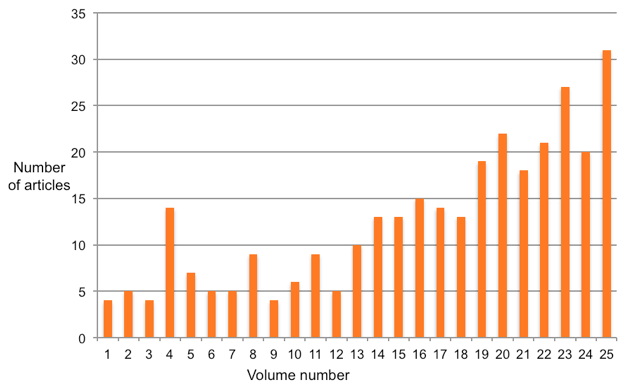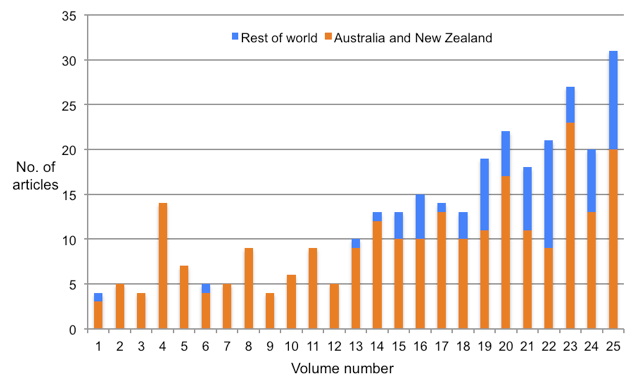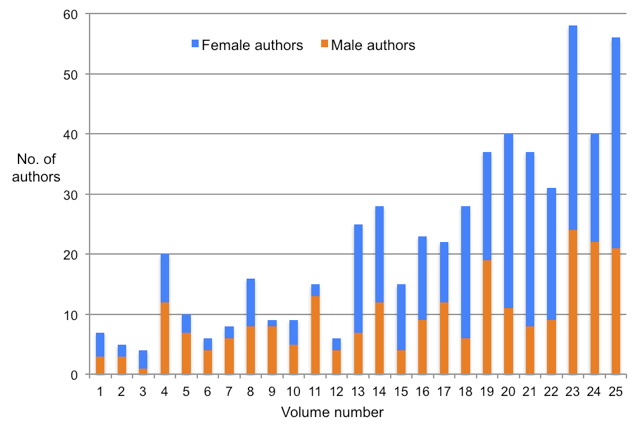
 |
Editorial 25(4): Surfing the waves of change in IIER's first 25 years
IIER 25(4) marks the end of this journal's first quarter century of publication, and to celebrate that achievement, Editorial 25(4) attempts to provide a 'reflective retrospective'. We considered a number of subtitles for this editorial, arriving at a short list of three, distinguished by their key phrases: 'identifying the big issues', 'surfing the waves of change', and 'sailing the winds of change'.
The phrase 'identifying the big issues' is attractive, because our list of big issues is frequently in mind, and no doubt also in the minds of the editorial staff for many other journals. In summary, the big issues are how to cope with increasing numbers of submissions from a more diverse population of authors; how to provide at least some formative advice to authors whose work was not accepted at initial review; how to further improve articles that have been accepted subject to revisions; and how to enhance IIER's bibliometrics relative to its peers. We should note that 'change' is also a good keyword which helps to summarise what IIER's editorial staff have faced in the past 25 years - a period of turbulent changes, so phrases which imply turbulence, such as 'surfing the waves' and 'sailing the winds', are also very appropriate.

Figure 1: Number of articles in IIER, vol 1 (1991) to vol 25 (2015)
(the counts are for research articles only; editorials and book reviews excluded)
Figure 1 shows the strong growth in the number of articles being published in each volume of IIER during the last 15 years. The number of issues per volume has grown in a similar way, from 1-2 issues during 1991-2008, to 3 issues during 2009-2014, and to 4 issues in 2015. This count includes three special issues: 20(1), 22(1) and 23(1). The confidence about growth of IIER expressed in Editorial 14(1) (Atkinson, 2004) seems well justified. However, a full assessment of this data for IIER awaits a study of growth rates for similar journals, accompanied by bibliometric data that can give insights into IIER's standing in the international community of educational researchers (see, for example, Atkinson & McBeath, 2010; Atkinson, 2012; IIER, 2015a).
Figure 2 provides one kind of a broad illustration of increasing diversity in the population of authors. For the first half of IIER's 25 years, accepted articles were almost exclusively from Australia, but after that period the representation of other countries has increased strongly. Again, we caution that Figure 2 is only a beginning, an entry point into a number of academic publishing issues actually or possibly associated with 'country of origin'. These include the larger workload that journal editorial staff may encounter when assisting authors whose first language is not English, and the finding of a place for wisdom that is non-Western.

Figure 2: Numbers of articles in IIER, vol 1 (1991) to vol 25 (2015), by country of origin
(country of origin is determined by the institutional affiliation of the article's first author, at the time the research was conducted)
Within this brief editorial, we cannot explore these issues in depth, but we can indicate some general directions and action priorities. During 2015, submissions have averaged about 10 per month, compared with about 5 per month in 2014, and therefore the matter of coping with increasing numbers of submissions is a high priority. IIER's main responses to date have been increasing the number of editorial staff, introducing the role of 'duty editor' to spread the editorial workload, and using the associate editors to prepare 'editorial rejects' (about 45% in 2015), without recourse to IIER's Editorial Board and external reviewers. Our current efforts are centred upon providing good research development advice for authors of rejected submissions, and attaining further improvements in articles that have been accepted subject to revisions. These are by far the most labour intensive activities for IIER, and in future we may be looking for new volunteers, especially from amongst retired academics, given that the Internet now enables academic publishing activities to be conducted from the simplest of home offices. The perspective represented here is that academic publishing should always do more than make learned, expert judgments upon submissions. It is equally or even more important to work with authors to improve their research and their future submissions, though that may be much more time consuming for editorial staff and reviewers.
IIER's publications expenses are exceedingly modest, given that editorial staff work is entirely honorary and that the print version was retired at end 2007 (McBeath & Atkinson, 2007). Now, IIER's only expenses are for the website, hosted by Sydney-based company Netregistry Pty Ltd, currently incurring an annual cost of A$17.48 for the iier.org.au domain name (paid by WAIER), and no expenses for website hosting, as iier.org.au is actually a 'no-extra-charge' subdomain iier.waier.org.au within waier.org.au, for which WAIER pays the annual hosting expenses, currently $142.95. Our level of service includes 20 GB storage and a data traffic allowance of 20 GB per month; currently IIER traffic is about 6-7 GB per month and storage about 0.15 GB. So there is considerable room for growth before we have to increase payments for the next higher level of service! Our Netregistry hosting also includes access to the listserver we use for 'alerts' purposes (IIER, 2015b), currently numbering 708 subscribers, and access to website statistics created by two programs, AWStats and Webalizer (though to date we have made little use of these).
In earlier times, 'publicity' for a journal and its articles tended to be concentrated upon obtaining 'indexing' in major databases that help researchers to find relevant publications. Whilst that remains important (e.g. IIER, 2015c), the main avenue for researchers to find relevant articles from a very small scale publisher such as the Institutes for Educational Research is via Internet search engines, especially Google and Google Scholar. Fortunately for IIER and its editorial staff, conformance with their guidelines (Google Scholar, 2015) is a relatively easy and quickly completed task for each article. Whilst the main avenue for attracting readers is Google and our open access status, for attracting authors we are also relying greatly upon building a reputation for good services and product. IIER does not require authors to pay for publication, unlike many of the newer open access journals; we try to greet new authors with a 'human voice' in contrast to a 'computer program voice'; we try to provide prompt and extensive editorial advice for both successful and unsuccessful authors; and for accepted articles we try through copy editing and proof reading to assist authors to attain a high standard of academic English. Recognising contemporary changes in author demographics (Figure 2), we seek to establish a reputation for acceptance of good quality articles from non-Western countries.
Turning now to the perspective expressed by the phrases 'surfing the waves' and 'sailing the winds', IIER's first 25 years has been a period of profound change. The magnitude of the technological changes can be illustrated by comparing IIER's publication routines in earlier times with the present day routine. For the first 15 volumes of IIER, we sent laser-printed hardcopy to a printing service; then for several years we took a CD containing PDF files to a printing service; now since the last print version in 2007, the Internet has done the work, taking only a few minutes to upload the files to iier.org.au/iier25/ (the upload will finish before we are halfway through our first celebratory glass of wine :-). The first 17 volumes required much work in printing and affixing address labels on envelopes; now for 25(4) it is click "Send" to IIER's alerts list (IIER, 2015b) and the Internet delivers the alert to about 708 addresses. Within a few days, a Google 'bot' will find the new files and world wide 'findability' happens. No need to post hard copy or PDF files to ERIC and other database providers, as was done until about volume 17.
However, enthusiasm for the technologies that have revolutionised academic and other domains of publishing should not divert attention from other profound changes. One of the most notable changes in author demographics is illustrated in Figure 2, namely recent marked increases in the proportion of 'Rest of world' articles.
Another notable change in author demographics is shown in Figure 3. The proportion of IIER authors who are females has increased quite markedly. Whilst Figure 3 reflects societal changes to which journal publishing policies make no contribution, it is possible, in at least some contexts, to surmise that the educational research community is 'leading the way', ahead of other sectors in society. Many will agree, hopefully, that 'leading the way' is an appropriate position for educational researchers and other research communities.

Figure 3: Gender of authors of articles in IIER, vol 1 (1991) to vol 25 (2015)
(count is all authors, except 8 (1.4%) for whom gender was not ascertainable by simple searches; authors with two articles are counted twice, etc.)
Roger Atkinson
IIER Associate Editor
Clare McBeath
IIER Publisher
Anne Power
IIER Editor
Atkinson, R. & McBeath, C. (2010). Editorial 20(3): ARC to revise the ranked journal lists. Issues In Educational Research, 20(3), ii-iv. http://www.iier.org.au/iier20/editorial20-3.html
Atkinson, R. (2012). Editorial 28(7): AJET review process outcomes: 2011 data. Australasian Journal of Educational Technology, 28(7), iii-vi. http://ajet.org.au/index.php/AJET/article/view/789/89
Atkinson, R. (2013). Journals with borders, journals without borders: Under-representation of Asian countries in educational research journals. Higher Education Research & Development, 32(3), 507-510. http://dx.doi.org/10.1080/07294360.2013.790528
Google Scholar (2015). Inclusion guidelines for webmasters. https://scholar.google.com.au/intl/en/scholar/inclusion.html
IIER (2015a). IIER bibliometrics. http://www.iier.org.au/about/iier-bibliometrics.html
IIER (2015b). IIER Alerts: Emailing list notification of new issues. http://www.iier.org.au/about/alerts.html
IIER (2015c). About IIER: Indexing. http://www.iier.org.au/iier-inf.html#indexing
IIER (2015d). How to search IIER. http://www.iier.org.au/about/iier-search.html
McBeath, C. & Atkinson, R. (2007). Editorial 17(2). Issues In Educational Research, 17(2), v-vii. http://www.iier.org.au/iier17/editorial17-2.html
| Please cite as: Atkinson, R., McBeath, C. & Power, A. (2015). Editorial 25(4): Surfing the waves of change in IIER's first 25 years. Issues in Educational Research, 25(4), ii-vi. http://www.iier.org.au/iier25/editorial25-4.html |